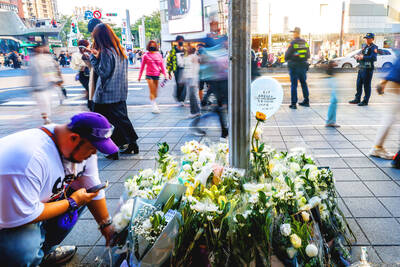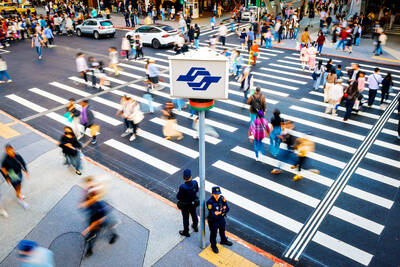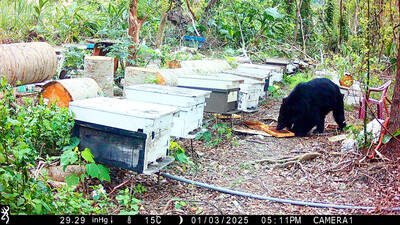Most drivers with outstanding freeway toll fees did not pay their bills because they forgot or did so in protest against the freeway Electronic Toll Collection (ETC) system, a National Freeway Bureau survey showed.
The system was implemented in December 2013, billing drivers automatically per kilometer traveled on freeways. Since then, outstanding bills have accumulated to more than NT$800 million (US$28.54 million).
The bureau had tasked Taiwan Real Survey Co to find out why drivers do not pay toll fees and if they know the legal consequences.
The survey showed that 47.2 percent of drivers with outstanding fees said they forgot to pay, while 41 percent said they purposely did not pay, as they were dissatisfied with the toll collection policy.
Twenty-eight percent said they did not pay their due fees because of financial difficulties, while 21.4 percent said they thought they would not get caught for not paying, the survey showed.
However, when asked in general why people might skip their payments, 35.3 percent of respondents said they believed it was in protest against the system, it showed.
About 27 percent said that people might have forgotten to pay, while 26.2 percent said financial difficulties might be the main reason, the survey showed.
Nearly 22 percent said people might believe they would not be punished for not paying, it showed.
However, 69.4 percent said they are aware that they might have to pay administrative and late fees if they miss their due dates, it showed.
About 53 percent said they know that the Administrative Enforcement Agency would be in charge of collecting overdue fees if those billed keep ignoring notifications, the survey showed.
Nearly 90 percent said that it is unfair and unjust that some drivers do not pay their fees.
Kao Shih-yuan (高世垣), a consultant at the polling firm, said that the National Freeway Bureau should explore further why some drivers do not pay their fees, incentivize payment and increase fines.
Drivers with overdue fees should be notified of the consequences of their inaction, Kao said, adding that payments through cloud systems should be accepted.
Eric Yu (俞振華), an associate professor in National Chengchi University’s politics department, said that the phenomenon of drivers being unwilling to pay their fees might have been influenced by controversies when the Electronic Toll Collection system replaced a manual system.
“The contractor running the ETC system clearly has an image issue and needs to reshape it. Meanwhile, people need to know why they need to pay toll fees and what the government uses the money for,” Yu said.
Bureau data showed that payments would contribute to the Freeway Construction Fund, which is used to construct and maintain freeways.
The fund’s accumulated debt exceeds NT$150 billion, with revenue of NT$22 billion to NT$23 billion per year and a payment default rate of 0.8 percent.
Last year, 50,000 ETC account holders with unpaid fees of more than NT$300 each were reported to the Administrative Enforcement Agency.
Ninety-eight percent of them owed less than NT$20,000, while 11 account holders owed more than NT$200,000, the bureau said, adding that the highest overdue bill was NT$850,000.
The survey, which was conducted from June 18 to 20, collected 1,082 valid samples. The margin of error was 2.98 percent.

SHIPS, TRAINS AND AUTOMOBILES: The ministry has announced changes to varied transportation industries taking effect soon, with a number of effects for passengers Beginning next month, the post office is canceling signature upon delivery and written inquiry services for international registered small packets in accordance with the new policy of the Universal Postal Union, the Ministry of Transportation and Communications said yesterday. The new policy does not apply to packets that are to be delivered to China, the ministry said. Senders of international registered small packets would receive a NT$10 rebate on postage if the packets are sent from Jan. 1 to March 31, it added. The ministry said that three other policies are also scheduled to take effect next month. International cruise ship operators

HORROR STORIES: One victim recounted not realizing they had been stabbed and seeing people bleeding, while another recalled breaking down in tears after fleeing A man on Friday died after he tried to fight the knife-wielding suspect who went on a stabbing spree near two of Taipei’s busiest metro stations, Taipei Mayor Chiang Wan-an (蔣萬安) said. The 57-year-old man, identified by his family name, Yu (余), encountered the suspect at Exit M7 of Taipei Main Station and immediately tried to stop him, but was fatally wounded and later died, Chiang said, calling the incident “heartbreaking.” Yu’s family would receive at least NT$5 million (US$158,584) in compensation through the Taipei Rapid Transit Corp’s (TRTC) insurance coverage, he said after convening an emergency security response meeting yesterday morning. National

PLANNED: The suspect visited the crime scene before the killings, seeking information on how to access the roof, and had extensively researched a 2014 stabbing incident The suspect in a stabbing attack that killed three people and injured 11 in Taipei on Friday had planned the assault and set fires at other locations earlier in the day, law enforcement officials said yesterday. National Police Agency (NPA) Director-General Chang Jung-hsin (張榮興) said the suspect, a 27-year-old man named Chang Wen (張文), began the attacks at 3:40pm, first setting off smoke bombs on a road, damaging cars and motorbikes. Earlier, Chang Wen set fire to a rental room where he was staying on Gongyuan Road in Zhongzheng District (中正), Chang Jung-hsin said. The suspect later threw smoke grenades near two exits

The Forestry and Nature Conservation Agency yesterday launched a gift box to market honey “certified by a Formosan black bear” in appreciation of a beekeeper’s amicable interaction with a honey-thieving bear. Beekeeper Chih Ming-chen (池明鎮) in January inspected his bee farm in Hualien County’s Jhuosi Township (卓溪) and found that more than 20 beehives had been destroyed and many hives were eaten, with bear droppings and paw prints near the destroyed hives, the agency said. Chih returned to the farm to move the remaining beehives away that evening when he encountered a Formosan black bear only 20m away, the agency said. The bear